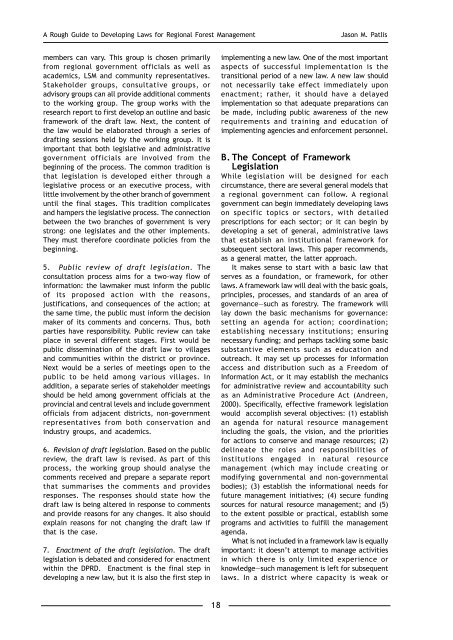A rough guide to developing laws for regional forest management
A rough guide to developing laws for regional forest management
A rough guide to developing laws for regional forest management
Create successful ePaper yourself
Turn your PDF publications into a flip-book with our unique Google optimized e-Paper software.
A Rough Guide <strong>to</strong> Developing Laws <strong>for</strong> Regional Forest Management<br />
Jason M. Patlis<br />
members can vary. This group is chosen primarily<br />
from <strong>regional</strong> government officials as well as<br />
academics, LSM and community representatives.<br />
Stakeholder groups, consultative groups, or<br />
advisory groups can all provide additional comments<br />
<strong>to</strong> the working group. The group works with the<br />
research report <strong>to</strong> first develop an outline and basic<br />
framework of the draft law. Next, the content of<br />
the law would be elaborated th<strong>rough</strong> a series of<br />
drafting sessions held by the working group. It is<br />
important that both legislative and administrative<br />
government officials are involved from the<br />
beginning of the process. The common tradition is<br />
that legislation is developed either th<strong>rough</strong> a<br />
legislative process or an executive process, with<br />
little involvement by the other branch of government<br />
until the final stages. This tradition complicates<br />
and hampers the legislative process. The connection<br />
between the two branches of government is very<br />
strong: one legislates and the other implements.<br />
They must there<strong>for</strong>e coordinate policies from the<br />
beginning.<br />
5. Public review of draft legislation. The<br />
consultation process aims <strong>for</strong> a two-way flow of<br />
in<strong>for</strong>mation: the lawmaker must in<strong>for</strong>m the public<br />
of its proposed action with the reasons,<br />
justifications, and consequences of the action; at<br />
the same time, the public must in<strong>for</strong>m the decision<br />
maker of its comments and concerns. Thus, both<br />
parties have responsibility. Public review can take<br />
place in several different stages. First would be<br />
public dissemination of the draft law <strong>to</strong> villages<br />
and communities within the district or province.<br />
Next would be a series of meetings open <strong>to</strong> the<br />
public <strong>to</strong> be held among various villages. In<br />
addition, a separate series of stakeholder meetings<br />
should be held among government officials at the<br />
provincial and central levels and include government<br />
officials from adjacent districts, non-government<br />
representatives from both conservation and<br />
industry groups, and academics.<br />
6. Revision of draft legislation. Based on the public<br />
review, the draft law is revised. As part of this<br />
process, the working group should analyse the<br />
comments received and prepare a separate report<br />
that summarises the comments and provides<br />
responses. The responses should state how the<br />
draft law is being altered in response <strong>to</strong> comments<br />
and provide reasons <strong>for</strong> any changes. It also should<br />
explain reasons <strong>for</strong> not changing the draft law if<br />
that is the case.<br />
7. Enactment of the draft legislation. The draft<br />
legislation is debated and considered <strong>for</strong> enactment<br />
within the DPRD. Enactment is the final step in<br />
<strong>developing</strong> a new law, but it is also the first step in<br />
implementing a new law. One of the most important<br />
aspects of successful implementation is the<br />
transitional period of a new law. A new law should<br />
not necessarily take effect immediately upon<br />
enactment; rather, it should have a delayed<br />
implementation so that adequate preparations can<br />
be made, including public awareness of the new<br />
requirements and training and education of<br />
implementing agencies and en<strong>for</strong>cement personnel.<br />
B. The Concept of Framework<br />
Legislation<br />
While legislation will be designed <strong>for</strong> each<br />
circumstance, there are several general models that<br />
a <strong>regional</strong> government can follow. A <strong>regional</strong><br />
government can begin immediately <strong>developing</strong> <strong>laws</strong><br />
on specific <strong>to</strong>pics or sec<strong>to</strong>rs, with detailed<br />
prescriptions <strong>for</strong> each sec<strong>to</strong>r; or it can begin by<br />
<strong>developing</strong> a set of general, administrative <strong>laws</strong><br />
that establish an institutional framework <strong>for</strong><br />
subsequent sec<strong>to</strong>ral <strong>laws</strong>. This paper recommends,<br />
as a general matter, the latter approach.<br />
It makes sense <strong>to</strong> start with a basic law that<br />
serves as a foundation, or framework, <strong>for</strong> other<br />
<strong>laws</strong>. A framework law will deal with the basic goals,<br />
principles, processes, and standards of an area of<br />
governance—such as <strong>for</strong>estry. The framework will<br />
lay down the basic mechanisms <strong>for</strong> governance:<br />
setting an agenda <strong>for</strong> action; coordination;<br />
establishing necessary institutions; ensuring<br />
necessary funding; and perhaps tackling some basic<br />
substantive elements such as education and<br />
outreach. It may set up processes <strong>for</strong> in<strong>for</strong>mation<br />
access and distribution such as a Freedom of<br />
In<strong>for</strong>mation Act, or it may establish the mechanics<br />
<strong>for</strong> administrative review and accountability such<br />
as an Administrative Procedure Act (Andreen,<br />
2000). Specifically, effective framework legislation<br />
would accomplish several objectives: (1) establish<br />
an agenda <strong>for</strong> natural resource <strong>management</strong><br />
including the goals, the vision, and the priorities<br />
<strong>for</strong> actions <strong>to</strong> conserve and manage resources; (2)<br />
delineate the roles and responsibilities of<br />
institutions engaged in natural resource<br />
<strong>management</strong> (which may include creating or<br />
modifying governmental and non-governmental<br />
bodies); (3) establish the in<strong>for</strong>mational needs <strong>for</strong><br />
future <strong>management</strong> initiatives; (4) secure funding<br />
sources <strong>for</strong> natural resource <strong>management</strong>; and (5)<br />
<strong>to</strong> the extent possible or practical, establish some<br />
programs and activities <strong>to</strong> fulfill the <strong>management</strong><br />
agenda.<br />
What is not included in a framework law is equally<br />
important: it doesn’t attempt <strong>to</strong> manage activities<br />
in which there is only limited experience or<br />
knowledge—such <strong>management</strong> is left <strong>for</strong> subsequent<br />
<strong>laws</strong>. In a district where capacity is weak or<br />
18

















